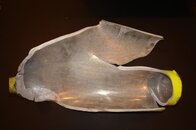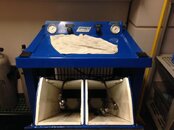For future reference your friend apparently has VERY limited experience. Some would just say your friend is ignorant, but I won't use that term as it may be offensive (even if I think it applies). The majority of scuba cylinders are filled 'out of the water'.I was driven there by a friend, who commented he had not seen tanks filled before out of the water.
LOL. It is certainly the prerogative of that diver to take that position. I suspect he also has very limited experience. And, I would not necessarily follow his lead on the subject. The challenge here is very much like the issues with the Internet in general. Absurd comments are made, and somehow become accepted as fact. You could do the same with mine, if you wish, although i suspect mine are factual.Another diver had just walked out of the store after his first visit, and commented there was no way they filled them without being in the water. He then felt the tank, and said, yup, filled out of the water. He said he would not have his tanks filled here.
No, and Yes. But, in reality, it depends. I have received filled cylinders on many occasions that were quite hot to the touch - I was traveling, I needed a quick fill at a local fill site, and they were hot when I took them. I didn't have time for cooling them in water. I have also filled cylinders for customers, and myself, where time was limited, and I just needed 'most of the rated capacity', and the cylinders were hot when given back to the customer. Ordinarily, what we will do is fill the cylinder, take it outside and place it in a fresh water bath to let it cool for a few minutes, then bring it back in and finish filling back to, or slightly above, the rated service pressure. Where the customer doesn't pick the cylinder up for several days, the cylinder temperature returns to ambient over that period (as heat dissipates from the metal into the atmosphere), so it doesn't feel hot. Getting water in the cylinder? Please. If you open the valve and blow air (and residual water) out of the aperture, if you take a paper towel and wipe the valve aperture, ETC. you will not inject any significant amount of water. More water would be injected if the fill air is humid and not filtered.]Is it normal to give them back very very hot? Is it normal to fill them without cooling in water?
As for concerns about the fresh rinse water being contaminated with salt water with repeated use, yes that can happen. Most competent fill operators drain and refill water baths each day, if there are salt water-immersed cylinders being brought in. We are an inland shop, where most of the cylinders will have been in fresh quarry water. Nonetheless, we refresh at least every other day.
A fill station that puts bleach in their water rinse bath and doesn't bother to mention it to their customers - twits. Customers who don't bother to ask - . . .
Last edited:






